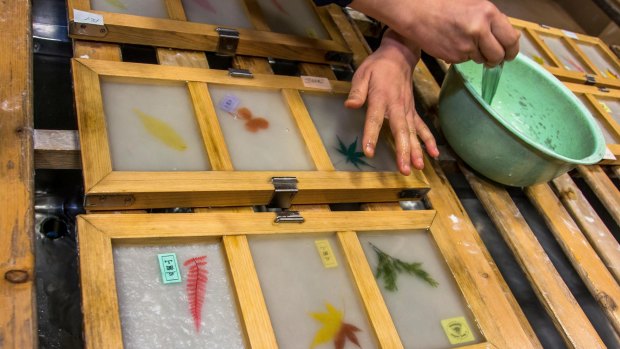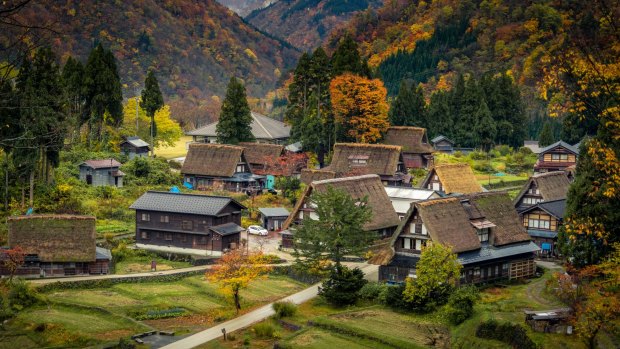This was published 5 years ago
Things you can do in Gokayama, Japan, when the weather turns bad
By Nina Karnikowski

The papermaking factory in Gokayama, Japan where paper called Gokayama washi paper is made from a mixture of mulberry trees.Credit: Alamy
The typhoon has been a major conversation topic since the moment I arrived at Tokyo's Haneda airport three days ago. One of the first questions my local guide – a jolly, 60-something fellow named Ike Sakurai – asked with a wide smile when we met in the arrivals lounge was, "Have you heard about the typhoon?"
Being Australian, typhoons aren't something I am overly familiar with. My brain flashed immediately to that scene from the '90s film Twister, where Helen Hunt straps herself to a pump to avoid being sucked into the vortex.
"Err, no … is that something to worry about?" I replied, trying to sound casual. Ike said no, there are a couple a month in Japan, nothing major. And yet, he continued pointing out the red-circled weather pattern's progress towards us multiple times a day on his iPad.

Traditional Houses in the gassho style in Ainokura Village. Credit: Joshua Hawley
By this morning, day three of our adventure through Japan's wild, green heart, I'm not terribly shocked when Ike tells us our trek through the foothills of the Japanese Alps – the activity I had been most looking forward to – has been cancelled. I take a deep breath, try to remember that the best travel experiences often happen when plans go awry, and let the day flow as it may.
Rather than hiking, our day begins instead with a visit to the World Heritage-listed village of Ainokura, hidden far back enough in a valley of the Gokayama region that it has been able to preserve much of its distinctive traditional culture. Thickly forested with cedar trees and dotted with 23 ancient wooden, thatched cottages, it feels a bit like wandering through Hobbiton.
Way back in the 12th century, says Ike, the Taira clan of samurai fled to these mountains following a terrible battle defeat, eventually leading this section of forest to develop into a small town. As we walk along gravelled laneways lined with purple wildflowers and small rice fields, the air filled with the thick chorus of cicadas, Ike tells us that the oldest of the A-shaped gassho-style farmhouses we're passing were built 400 years ago. The steep angle of the roof was essential due to the heavy snowfall the region receives in winter, when Ainokura gets buried under more than two metres.
Ike ushers us inside one which today functions as a cosy family-run guesthouse, so we can check out the irori, or traditional sunken hearth, and the simple tatami rooms separated by rice paper screens. We're only six hours drive from the neon blaze of Tokyo, but it feels as though it could be centuries.
I'd love to stay and spend a night in one of the mysterious cottages, to experience the unfolding of an evening in this village, which seems as potent a reminder as any of where Japan has come from. But Ike points to the charcoal sky. The typhoon is coming, he says with an excited grin, we must go.
Gokayama and neighbouring Shirakawa-go have become famous for producing washi, a handmade mulberry paper that has been made in Japan for 600 years, and is so hardy handbags are made from it. By the time we reach our next unscheduled stop, a small washi paper factory just north of Ainokura, the rain is coming down in fat pellets. We dash inside with our bags over our heads and watch a video about the laborious process of making this paper, which is steamed, peeled, dried, scraped and naturally bleached by snow into its final form. Later, we try our hand at making it, dipping small mesh pans into big vats of soggy, papery mush, which we then strain and dry on a sheet of heated metal. We leave with our own trio of washi postcards, and a newfound respect for this age-old process.
It's time to eat. Ike takes us to a tasty mountain vegetarian restaurant, where the vegetables we devour – all explained on a laminated card, and including an unexpectedly delicious tree fern – are harvested by the adorable elderly owner and her two friends. Thanks to the turbulent weather we're the only ones in the restaurant, so the three women decide to treat us to a folk song and dance. The kokiriko bushi is Japan's oldest traditional dance dating back 1400 years, and was originally a form of prayer for bountiful harvests. The women give us their own version of the kokiriko using the binzasara, a string-bound percussion instrument crafted from 108 pieces of Japanese cypress, which they wave above their heads to make a crisp, ratchet-like sound. I could watch the women, with their permed hair and gingham aprons, shuffle-dance around the restaurant for hours. Alas, the rain is now sloshing down in sheets, and Ike says we must hurry to our lodgings three hours earlier than expected.
Thankfully, tonight's accommodation is in Hirayu Onsen, the oldest and largest of the five onsen towns in Okuhida, a district famous for its natural hot springs. Within half an hour of checking in, I'm sinking into a private rotenburo hot spring bath that is open to the sky. The typhoon rages overhead as I soak in the mineral-rich waters, feeling grateful for our change of plans and this unexpectedly leisurely afternoon.
At some point, the small stone fountain feeding the bath stops running. The power has gone out, and will be out all evening. Later, while eating our multi-course traditional kaiseki dinner by candlelight, Ike will tell us that 91,000 houses in the Gifu Prefecture lost power this evening. For now though, I'm happy to simply lay in the swelling darkness. Head tilted back, arms pressed open to the furious sky, welcoming the power of wild Japan.
FIVE THINGS TO DO AROUND GOKAYAMA
AINOKURA MUSEUM
Wander through Ainokura village to this folk museum which includes displays of local crafts and paper, and tools and farming implements used by the original settlers. See gokayama-info.jp
VISIT MURAKAMI-KE
One of Gokayama's oldest gassho-style houses dating back to 1578, Murakami-ke now functions as a small museum and has been officially designated as an Important Cultural Property for Japan. Sit around the fire pit and sip tea while listening to the owner's stories. If you're lucky, he might even sing you a local folk song.
SHIRAKAWA-GO
A 45-minute drive from Ainokura sits a larger UNESCO-protected gassho-house village called Shirakawa-go. There are about 59 of the A-frame houses here, in which not a single nail has been used in the construction. See shirakawa-go.org
OGIMACHI CASTLE RUINS LOOKOUT
Set on the site of a former castle, this observatory is an eight-minute walk from Shirakawa-go and has a stunning view of the valley and village below. Bring your camera, it's a famous selfie spot.
GOKAYAMA FOLK CENTRE
Gokayama was once famous for its gunpowder, and in this folklore museum in Suganuma you'll see items used in traditional gunpowder production, as well as other bits and pieces that tell the story of the Edo period's main industries.
TRIP NOTES
Nina Karnikowski travelled as a guest of the Japan National Tourism Organisation.
MORE
FLY
Qantas flies from Sydney and Melbourne to Tokyo. From there, it's about a six-hour drive to Gokayama. See qantas.com
Sign up for the Traveller Deals newsletter
Get exclusive travel deals delivered straight to your inbox. Sign up now.